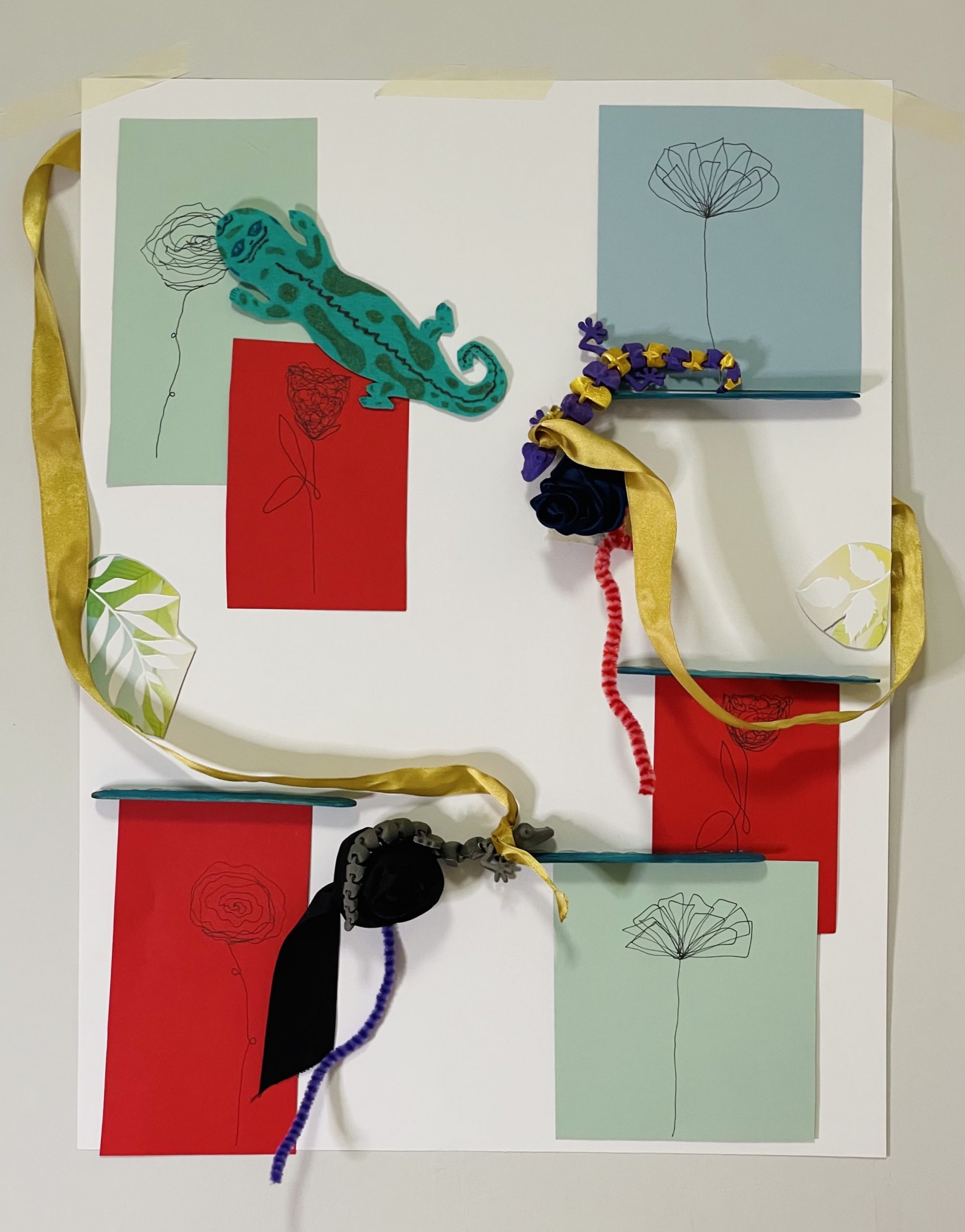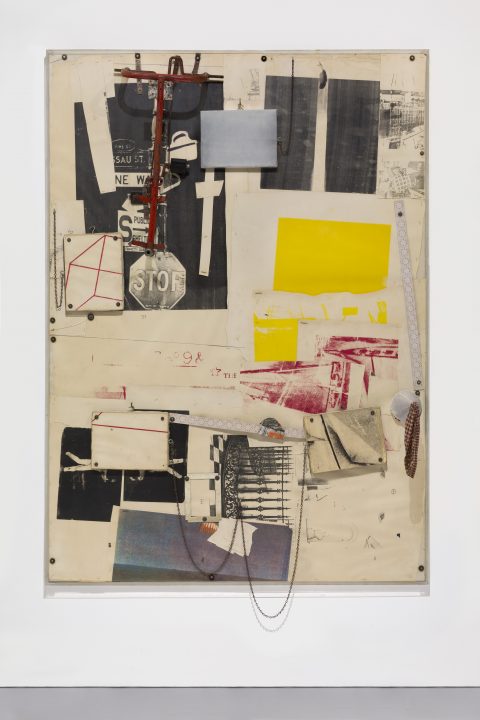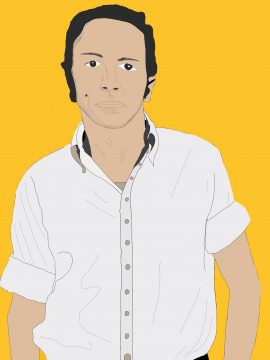Combine Design

Who inspires you? Combine objects, images, and other materials to make a unique work of art inspired by someone important to you.
Time: 45–60 minutes
Skill Level: Advanced
Topic: Dedication
LOOK CLOSELY

Robert Rauschenberg, Fossil for Bob Morris, 1965. Gift of Joseph H. Hirshhorn, 1972
Look closely. Let your eyes wander across the artwork. What do you see? Describe the materials, the shapes, and the colors. Are there any items that look familiar to you?
You might have noticed black-and-white photographs of street signs, part of a red bike frame, a plastic funnel containing a piece of brown cloth, several red and yellow prints, and a metal chain dangling off the bottom of the canvas.
This artwork is by Robert Rauschenberg and is called Fossil for Bob Morris. The title is in honor of Rauschenberg’s friend Robert Morris (Bob is short for Robert). Rauschenberg was friends with many artists, and liked to work together on projects. His friend Bob Morris was a sculptor and a dancer. If you look really closely, you might notice a black and white image of Morris dancing in Fossil for Bob Morris. Can you find it? Hint: Look in the lower left corner.
Sometimes, Rauschenberg created artworks you could play with. Fossil for Bob Morris features four rectangles hanging from hooks, connected by a chain. These rectangles could be moved and rearranged, changing how the artwork looked.
MEET RAUSCHENBERG

Drawing of Robert Rauschenberg by Anne Matlock for the Hirshhorn Museum and Sculpture Garden.
Robert Rauschenberg (1925–2008) was an American artist known for combining many types of art together and using objects that were not usually considered art materials. Rauschenberg was very creative and liked to work with his hands. As a child, he built a wall between his side of the room and his sister’s side of the room using crates and boxes he found. While serving in the US Navy in California, he visited a museum for the first time. Seeing paintings at the museum made him interested in making paintings, and he was inspired to buy himself art supplies.
After he left the Navy, Rauschenberg studied art in Paris and then at Black Mountain College in North Carolina. Rauschenberg made paintings, sculptures, prints, and performances; he also made up the word “combines” to describe some of his works. Combine means to mix together, and that’s just what Rauschenberg did with his combines! He placed objects, his own art prints, fabric, and other materials all together in one artwork, just like in Fossil for Bob Morris.
Want to learn more? See other works by Rauschenberg in the Hirshhorn collection. Read more about Rauschenberg’s life and work.
MAKE IT!
Who inspires you? Create a unique work of art inspired by a friend. For this project, we take inspiration from Robert Rauschenberg’s Fossil for Bob Morris. Rauschenberg created this work for his friend Bob Morris, who was also an artist.
- Gather planning materials: You’ll need a piece of paper and drawing tools, like a pencil or markers.

- Think about a person who inspires you. It could be a friend, a family member, or a favorite artist or personal hero. Fossil for Bob Morris is one of three artworks in a series that Rauschenberg created inspired by friends. For our model project, we made an artwork inspired by a sibling.

- Gather your materials: As you gather materials, think about the person you’re making the work for and find colors, images, and objects related to them. Take a scavenger hunt to find the best combination!
- You’ll need:
- Surfaces for your artwork (like a large poster board, piece of cardboard, and paper)
- Scissors, glue, and tape
- Plus an assortment of some of the following (the materials listed here are just examples–don’t worry if you can’t find these exact items):
- Found objects: items from your junk drawer, old toys, fabric, sticks, and other natural objects
- Found images: magazine images, old greeting cards, newspaper clippings, photographs
- Materials that connect objects together: popsicle sticks, string, twigs, chopsticks
- Materials that bend or move: pipe cleaners, paper chain, wire, rubber bands
- Personal materials: drawings and paintings you’ve made, doodles on scrap paper

- You’ll need:
- Plan your composition. Experiment with the placement of your materials.

- Sketch! Sometimes it helps to draw out your ideas. What is your vision and how is it inspired by the person you thought about earlier? How might you connect and combine the different pieces of your artwork together? Note: Many children, especially those under six, may do best skipping this step. Their best work will likely be in the process of experimenting and exploring different possibilities for using the materials (see step 4).

- Collage your canvases. Use your tape and glue to collage found objects and personal materials to your canvas.

- Make it move! Use materials that move to attach your smaller pieces to your large canvas. In Rauschenberg’s Fossil for Bob Morris, there are four rectangles hanging on hooks, connected by a chain. For our project, we used ribbon to attach movable lizard figures. What can you make move in your “combine” project?

- Keep working until you’re happy with your creation! Rauschenberg would keep working on his art until he was happy with it. We decided to add movable pipe cleaner stems to our ribbon flowers.

- Title and display your work. We named ours Garden for Sam and attached it to a wall. We dedicated our artwork to a brother for his birthday. If you dedicated your artwork to someone in your life, share a picture of your work with them!
